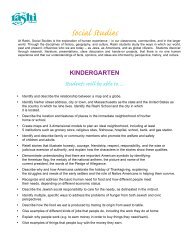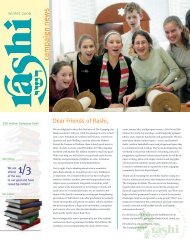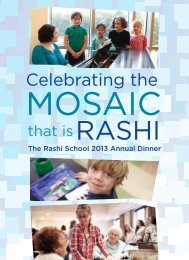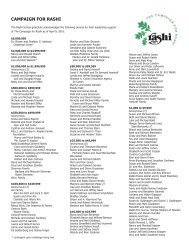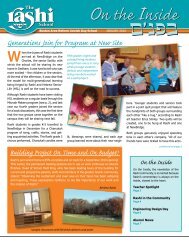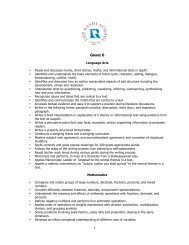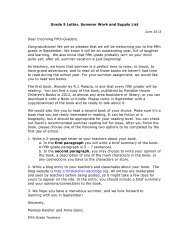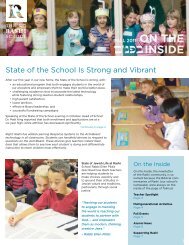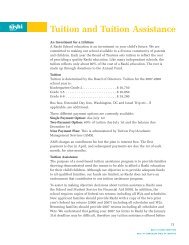Rashi Builds Jerusalem at it Celebrates Israel at ... - The Rashi School
Rashi Builds Jerusalem at it Celebrates Israel at ... - The Rashi School
Rashi Builds Jerusalem at it Celebrates Israel at ... - The Rashi School
Create successful ePaper yourself
Turn your PDF publications into a flip-book with our unique Google optimized e-Paper software.
Showcasing Science Throughout the <strong>School</strong><br />
Seventh graders wrote research papers and<br />
cre<strong>at</strong>ed an electronic quiz board on topics<br />
rel<strong>at</strong>ed to evolution. Kindergarten students<br />
(below) examined fish to note how they were<br />
similar to and different from people.<br />
How do animals stay warm in winter?<br />
Wh<strong>at</strong> is the rock cycle? Wh<strong>at</strong> is the Hebrew<br />
word for hail? W<strong>it</strong>h clipboards and<br />
pencils in hands, <strong>Rashi</strong> students examined<br />
the Science Showcase displays to find the<br />
answers to these and other “scavenger<br />
hunt” questions. <strong>The</strong> showcase highlighted<br />
the results of science learning in all grades,<br />
from kindergarteners’ research on ocean<br />
animals to eighth graders’ study of <strong>at</strong>oms.<br />
Children studied the Grade 3 moon<br />
display <strong>at</strong> the Science Showcase to<br />
answer such questions as: Wh<strong>at</strong> phase<br />
is the moon in on Rosh Hashana?<br />
<strong>The</strong> Science Showcase was held in conjunction<br />
w<strong>it</strong>h the annual grade 5 Science Fair (left),<br />
in which each fifth grader used the six-step<br />
scientific method to answer a question (Wh<strong>at</strong><br />
is the impact of music on concentr<strong>at</strong>ion?<br />
How are plants affected by light?) in an<br />
area of science of personal interest.<br />
<strong>Rashi</strong> students learn science content through inquiry. <strong>The</strong>y combine<br />
their powers of observ<strong>at</strong>ion w<strong>it</strong>h thoughtful predicting, experimental<br />
design, and d<strong>at</strong>a represent<strong>at</strong>ion and analysis to acquire a deep and<br />
lasting understanding of science concepts.<br />
Mishnah Comes to <strong>Rashi</strong><br />
It’s Pizza Thursday, and the group of middle schoolers<br />
in the third floor classroom is anxiously awa<strong>it</strong>ing the<br />
arrival of pizza. While they wa<strong>it</strong>, they are chanting the<br />
words of ancient rabbis and discussing how and when<br />
to read the Shema.<br />
This is Mishnah <strong>at</strong> <strong>Rashi</strong>. <strong>The</strong> study of rabbinics, or Oral<br />
Torah – the convers<strong>at</strong>ions of the rabbis over centuries<br />
th<strong>at</strong> have led to many of our current religious practices<br />
– has not been a part of the <strong>Rashi</strong> curriculum. But this<br />
year, Jewish Studies Director Rabbi Ellen Pildis and Jewish Program<br />
Coordin<strong>at</strong>or Dan Brosgol are bringing Mishnah to <strong>Rashi</strong><br />
on an elective basis.<br />
“Both students and parents are enthusiastic about the program,”<br />
noted Rabbi Ellen, “ and we are considering expanding <strong>it</strong> for next<br />
year.” She and Dan gave a present<strong>at</strong>ion on <strong>The</strong> Introduction of<br />
Mishnah Teaching in a Reform Jewish Day <strong>School</strong> <strong>at</strong> a recent<br />
Conference on Teaching Rabbinic L<strong>it</strong>er<strong>at</strong>ure held <strong>at</strong> Brandeis.<br />
Two groups of students –<br />
Middle <strong>School</strong>ers and fourth graders – have been<br />
meeting on a regular basis during lunchtime,<br />
chanting mishnayot and pondering the rabbis’<br />
opinions on topics such as preparing for Passover.<br />
Exposure to rabbinics will particularly benef<strong>it</strong> those students who<br />
plan to <strong>at</strong>tend a Jewish high school, but Rabbi Ellen explains th<strong>at</strong><br />
is <strong>it</strong> important for each child. “To think as a Jew,” she says, “means<br />
incorpor<strong>at</strong>ing thinking from our past into our modern ideas.”<br />
6 On the Inside – Spring 2008/Nisan 5768



